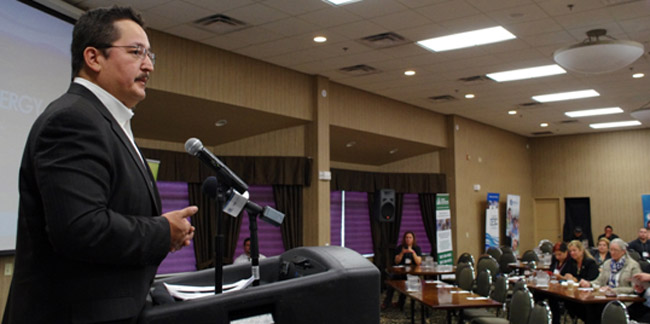Pic River venture highlighted during Aboriginal Partnership Exchange

By Rick Garrick
THUNDER BAY – Pic River’s plans to develop a hydro-electric project within Pukaskwa National Park were highlighted during the Thunder Bay Chamber of Commerce’s APEX Aboriginal Partnership Exchange.
“We are looking for opportunities to develop hydro projects where people are not accustomed to developing hydro electricity — inside a national park,” says Byron LeClair, Pic River’s director of energy projects. “People say it is impossible to develop hydro potential within a national park, but if the principles of the national park system are important within that national park, they are important outside. We are all part of the same eco system.”
Pic River submitted the Chigamiwinigum Falls hydro-electric facility proposal to the federal government in July 2014. The site is located on the White River within the Northern Superior community’s traditional territory. The community has already developed three generating stations: 13.5 MW Wawatay GS, 5.0 MW Twin Falls GS and 23.0 MW Umbata Falls GS.
“We generate about 195,000 megawatt hours of electricity, all sold into the grid,” LeClair says. “We supply about 20,000 homes in Ontario with electricity. We offset about 168,000 tons of CO2 per year. The total investment from 1987 to today is about $144 million.”
Pic River is also pursuing other power developments, including the High Falls hydro-electric project and the Superior Shores wind power project.
“In Pic River we have been very fortunate that we have had a core group of councillors in place for 30-35 years,” LeClair says. “We have had consistency in leadership, consistency in vision, consistency in execution of that vision.”
LeClair also recognized the Thunder Bay Chamber of Commerce’s leadership role in implementing programs that bring communities together, such as the chamber’s Status Cards Welcome sign.
“To see Joe Moses, who is a member of the Pic River First Nation, serve as chair for the chamber shows the leading vision that the chamber brings in terms of articulating what is important for the Thunder Bay business community, what is important with respect to their philosophy and their belief in partnership building,” LeClair says.
LeClair delivered A Success Story: Powering Change in Northwestern Ontario presentation during the June 4 APEX gathering at the Victoria Inn in Thunder Bay. Chief Clarence Louie, Osoyoos Indian Band, delivered the morning keynote address on A Pathway to Prosperity. Other speakers included Lakehead University’s Cynthia Wesley-Esquimaux, Nishnawbe Aski Development Fund’s Brian Davey, Matawa First Nations’s David Paul Achneepineskum and Thunder Bay Community Economic Development Commission’s Doug Murray.
“When we looked at our speaker panel, we wanted to get a good representation of the experts from outlying regions but we also have a lot of great examples within out local economy and region,” says Moses, chair of the Thunder Bay Chamber of Commerce and Pic River citizen. “So we wanted to tell the story within, that there are solutions within our back yard, but also get the broader perspective from outside to see what other nations are doing across the country as well.”
Held in partnership with Nishnawbe Aski Development Fund, the gathering included panel discussions on Establishing the Economic Landscape for Northwestern Ontario; Digging Deeper: Understanding the Cultural, Social, and Economic Impacts of First Nations Business; Aboriginal Solutions to the Workforce, Education, and Training Needs of the Future; “The Business” of Aboriginal Business: Finance, Legal, and Accounting Considerations; and Emerging Leaders.
“Today is about starting the dialogue, making people aware of some of those issues, as Clarence Louie puts, ‘some of those bigger questions,’” Moses says. “What is going on, why are things the way they are, how are we going to change things and how do we move forward.”


